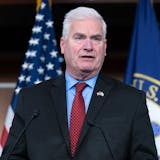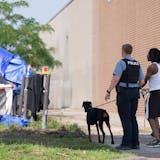Opinion editor’s note: Strib Voices publishes a mix of guest commentaries online and in print each day. To contribute, click here.
•••
On Sept. 4, two students and two teachers were killed in a shooting at Apalachee High School in Winder, Ga. After every mass shooting, we hear the same refrain: “We never thought it could happen here.” And while Winder, Ga., may feel half the world away, new data show that gun violence is not an abstract issue that happens somewhere else. In fact, in Minnesota, it’s a growing reality that touches every corner of our state, affecting our communities, schools, public spaces and mental health.
We are Minnesota-based professors who study gun violence. Our recent representative survey of over 1,000 Minnesotans aged 19 to 92 reveals just how deeply gun violence has touched our state. We asked them about their experiences with guns in their lifetimes. One in five Minnesotans reported being threatened with a gun and for 13% of Minnesotans, witnessing someone being shot is a traumatic memory they carry. Seven and a half percent have been directly shot at. And tragically, 4% of Minnesotans have been shot and injured. These numbers are more than statistics — they represent our friends, families and neighbors.
The impact is even more profound when we look at specific groups. Black Minnesotans are far more likely to experience gun violence. For example, 20% of Black Minnesotans in our survey self-reported having been shot at, compared with just 6% of white Minnesotans. Similarly, 14% of Black Minnesotans reported being present at a mass shooting where at least four people were shot, while only 3% of white Minnesotans say the same. These disparities speak to the urgent need for addressing gun violence as not just a public safety issue, but a matter of racial and social equity.
These issues are not confined to adults. Younger generations are growing up in a world where exposure to gun violence is more common than we might want to believe. Nine percent of Gen Z Minnesotans (born after 1997) have been present at the scene of a mass shooting and 2% have been injured in one. For millennials (born between 1981 and 1996), that number is 7%, with 3% injured. The future leaders of our state are living in a constant state of heightened awareness about their personal safety.
The mental health toll of this violence is staggering. Nearly half of all Minnesotans — 47% — are afraid of being shot in a public place. And of those who have been at the scene of a mass shooting, 90% report suffering from anxiety, depression or PTSD. Even those who weren’t physically present but live in a community that experienced a mass shooting report significant mental health challenges. The everyday fear and emotional trauma that permeates the lives of so many Minnesotans is something we can’t ignore. In a state where the debate over gun control has been front and center, this data takes on new urgency. This isn’t about politics — it’s about the safety and well-being of our communities.
Our new data make one thing clear: gun violence is not someone else’s problem — it’s all of ours. It affects people in rural communities, in cities and in suburbs. It crosses generational lines and racial boundaries. And while the solutions are complex, there are immediate steps we can take to address this crisis. For one, safe storage practices could help prevent many tragedies. While nearly one-third of Minnesotans reported owning a gun, only two-thirds of Minnesota gun owners reported consistently storing their firearms safely. The data show safe storage counseling, along with providing locks and safes, can be an effective preventative measure to reduce accidents and thefts that put guns in the hands of children or prohibited persons.



